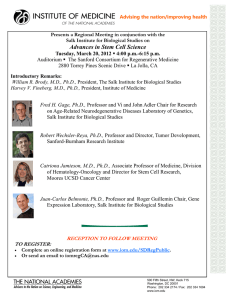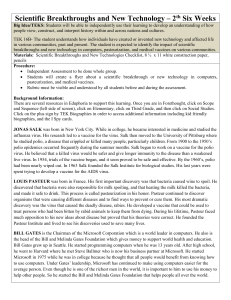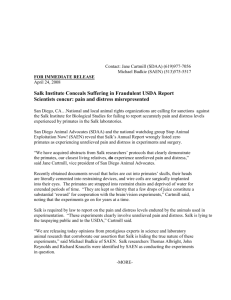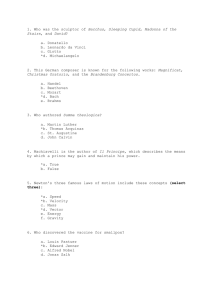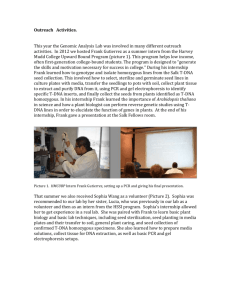Conquering Polio
advertisement
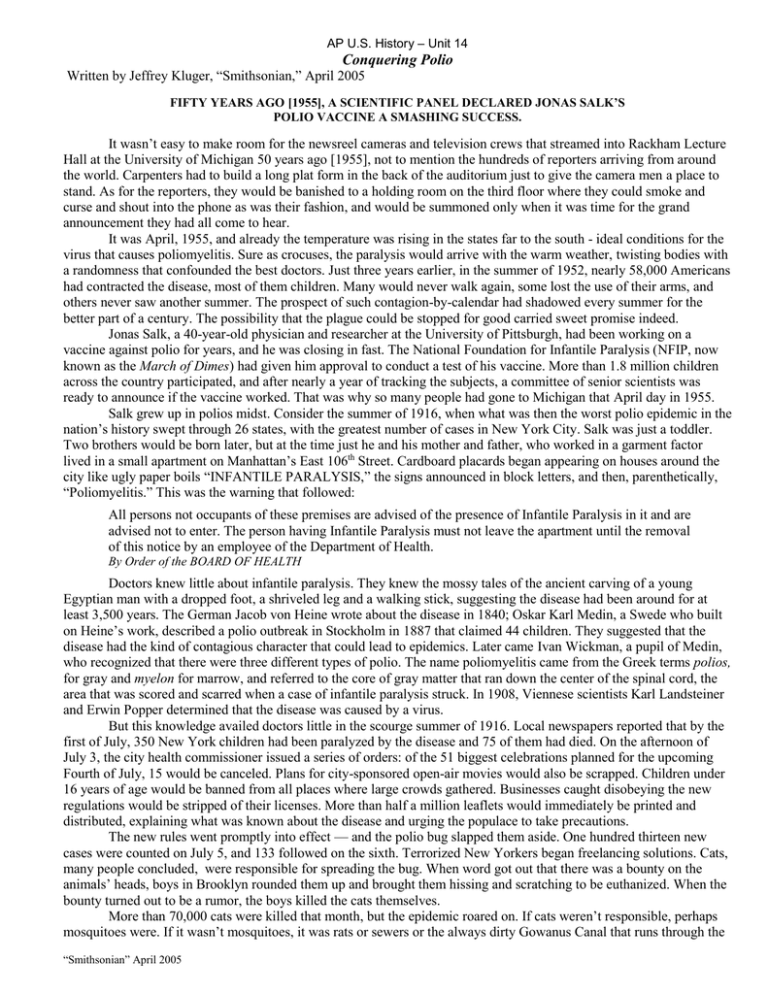
AP U.S. History – Unit 14 Conquering Polio Written by Jeffrey Kluger, “Smithsonian,” April 2005 FIFTY YEARS AGO [1955], A SCIENTIFIC PANEL DECLARED JONAS SALK’S POLIO VACCINE A SMASHING SUCCESS. It wasn’t easy to make room for the newsreel cameras and television crews that streamed into Rackham Lecture Hall at the University of Michigan 50 years ago [1955], not to mention the hundreds of reporters arriving from around the world. Carpenters had to build a long plat form in the back of the auditorium just to give the camera men a place to stand. As for the reporters, they would be banished to a holding room on the third floor where they could smoke and curse and shout into the phone as was their fashion, and would be summoned only when it was time for the grand announcement they had all come to hear. It was April, 1955, and already the temperature was rising in the states far to the south - ideal conditions for the virus that causes poliomyelitis. Sure as crocuses, the paralysis would arrive with the warm weather, twisting bodies with a randomness that confounded the best doctors. Just three years earlier, in the summer of 1952, nearly 58,000 Americans had contracted the disease, most of them children. Many would never walk again, some lost the use of their arms, and others never saw another summer. The prospect of such contagion-by-calendar had shadowed every summer for the better part of a century. The possibility that the plague could be stopped for good carried sweet promise indeed. Jonas Salk, a 40-year-old physician and researcher at the University of Pittsburgh, had been working on a vaccine against polio for years, and he was closing in fast. The National Foundation for Infantile Paralysis (NFIP, now known as the March of Dimes) had given him approval to conduct a test of his vaccine. More than 1.8 million children across the country participated, and after nearly a year of tracking the subjects, a committee of senior scientists was ready to announce if the vaccine worked. That was why so many people had gone to Michigan that April day in 1955. Salk grew up in polios midst. Consider the summer of 1916, when what was then the worst polio epidemic in the nation’s history swept through 26 states, with the greatest number of cases in New York City. Salk was just a toddler. Two brothers would be born later, but at the time just he and his mother and father, who worked in a garment factor lived in a small apartment on Manhattan’s East 106th Street. Cardboard placards began appearing on houses around the city like ugly paper boils “INFANTILE PARALYSIS,” the signs announced in block letters, and then, parenthetically, “Poliomyelitis.” This was the warning that followed: All persons not occupants of these premises are advised of the presence of Infantile Paralysis in it and are advised not to enter. The person having Infantile Paralysis must not leave the apartment until the removal of this notice by an employee of the Department of Health. By Order of the BOARD OF HEALTH Doctors knew little about infantile paralysis. They knew the mossy tales of the ancient carving of a young Egyptian man with a dropped foot, a shriveled leg and a walking stick, suggesting the disease had been around for at least 3,500 years. The German Jacob von Heine wrote about the disease in 1840; Oskar Karl Medin, a Swede who built on Heine’s work, described a polio outbreak in Stockholm in 1887 that claimed 44 children. They suggested that the disease had the kind of contagious character that could lead to epidemics. Later came Ivan Wickman, a pupil of Medin, who recognized that there were three different types of polio. The name poliomyelitis came from the Greek terms polios, for gray and myelon for marrow, and referred to the core of gray matter that ran down the center of the spinal cord, the area that was scored and scarred when a case of infantile paralysis struck. In 1908, Viennese scientists Karl Landsteiner and Erwin Popper determined that the disease was caused by a virus. But this knowledge availed doctors little in the scourge summer of 1916. Local newspapers reported that by the first of July, 350 New York children had been paralyzed by the disease and 75 of them had died. On the afternoon of July 3, the city health commissioner issued a series of orders: of the 51 biggest celebrations planned for the upcoming Fourth of July, 15 would be canceled. Plans for city-sponsored open-air movies would also be scrapped. Children under 16 years of age would be banned from all places where large crowds gathered. Businesses caught disobeying the new regulations would be stripped of their licenses. More than half a million leaflets would immediately be printed and distributed, explaining what was known about the disease and urging the populace to take precautions. The new rules went promptly into effect — and the polio bug slapped them aside. One hundred thirteen new cases were counted on July 5, and 133 followed on the sixth. Terrorized New Yorkers began freelancing solutions. Cats, many people concluded, were responsible for spreading the bug. When word got out that there was a bounty on the animals’ heads, boys in Brooklyn rounded them up and brought them hissing and scratching to be euthanized. When the bounty turned out to be a rumor, the boys killed the cats themselves. More than 70,000 cats were killed that month, but the epidemic roared on. If cats weren’t responsible, perhaps mosquitoes were. If it wasn’t mosquitoes, it was rats or sewers or the always dirty Gowanus Canal that runs through the “Smithsonian” April 2005 AP U.S. History – Unit 14 heart of Brooklyn. New Yorkers called, cabled and wrote the Department of Health with all manner of things they were certain were causing the plague, including high groundwater, ice-cream cones, excavations, flies, bedbugs, street dust, cornflakes, the subway, parasites in the water, alloys in cooking utensils, gases from munitions factories, the bent-over position children assumed at school desks, mercury poisoning, white clothing, earthquakes, volcanoes, electrical disturbances, sunburn, intestinal derangements, secondhand bedding, decayed food, excessive glare, unclean milk bottles, carrying coins in the mouth and tobacco. Tens of thousands of people decided to quit the city altogether. For families without the means to flee, like Jonas Salk’s, there was little to do but wait. Salk turned 2 years old in October, the same month the weather at last grew cool and New York City could begin to put the season of terror behind it. In the end, the doctors counted 27,000 cases of polio around the country, 6,000 of them fatal; 9,000 of the victims lived in the boroughs that made up New York City. Salk was too young to remember what his city endured that summer, but he had heard the tales and learned them well. Some 20 years later, he entered New York University Medical School with a plan to become not a practicing physician but a researcher. By the time a patient came wheezing or aching into a doctor’s office, he reasoned, a disease had already scored a hit. Better to develop ways to prevent people from getting sick in the first place. In 1942, not long after completing his residency, Salk had a chance to do just that, when he went to the University of Michigan to work with the celebrated microbiologist Thomas Francis. During World War I, millions of people worldwide had died of the great influenza pandemic, with soldiers on the European battlefields suffering worst of all. Now in the first full year of America’s involvement in World War II, the Army wanted no health crisis heaped on top of a military crisis and ordered Francis to develop a vaccine against influenza. Francis, in turn, conscripted Salk, whom he’d met at NYU when Salk was still a student. Within two years, Francis and Salk gave the military just what it had asked for - the world’s first influenza preventative. By 1947, Salk left Michigan and went to the University of Pittsburgh to establish his own research lab. With one disease under control, he would now go gunning for another. What he didn’t know was which one. The NCIP, founded on January 3, 1938 by Franklin Roosevelt - the world’s best-known polio victim - was always on the hunt for scientific talent. When word got out that Salk was available, the NCIP pounced, promising him lots of work and plenty of funds. Salk accepted, poured himself into basic polio research, and within a few years was trying to develop the elusive vaccine. Earlier vaccines, such as the one against yellow fever, had shown that being protected against a viral disease required catching a tiny case of it. The vaccine had to wake up the immune system so that it could learn to recognize the virus that causes the illness and then produce antibodies that would attack and kill the pathogen if it ever invaded the body. Most vaccines achieved this by using live viruses that had been bred to be so weak that they could infect the system with out doing any true harm. The problem was, there was always a chance the weakened virus could mutate back into a deadly form, afflicting the person with the very disease the vaccine was meant to prevent. But Salk preferred a vaccine made of a virus that had been not just weakened but killed - one that could introduce the bug to the body with no risk of illness at all. Salk and Francis had proved this approach could work with their influenza vaccine, made with killed virus. Salk was convinced this approach would stop polio as well. From I947 to 1952, Salk and his co-workers devoted themselves to polio, first coming up with techniques to prove the widely held theory that there were three different types of the virus, then working on a vaccine that could protect against all of them. To make the vaccine, they came up with ways to grow the polio virus and then kill it with diluted formaldehyde. Tests in lab dishes showed the techniques worked. Additional studies in mice and monkeys showed that the vaccines protected the animals from the virus — though many succumbed to the polio injections before Salk perfected his formula. In December 1951, the NFIP granted Salk permission to move on to people. The first human subjects Salk worked with were boys and girls who had already contracted polio. They would be carrying a load of antibodies in their blood and would be immune to contracting another case of the disease in the event the vaccine went awry. Salk first tested each child’s blood to determine which of the three types of poliovirus he or she carried and in what concentration. Then he injected a child with a vaccine made only from that viral type. Weeks later, he drew more of the subject’s blood to see if the antibody level had risen. If it had, this would be evidence that the vaccine did in fact prod the body to muster its defenses — a critical first step. Salk conducted his experiment at the D.T. Watson Home for Crippled Children in Leetsdale, Pennsylvania. On a hot morning in June of 1952, he set out for the Home, accompanied by a pair of nurses from the Municipal Hospital in Pittsburgh. They arrived in the auditorium at the appointed hour, the nurses attired in proper white uniforms, Salk in a tie and white lab coat. Salk walked to the front, shook hands with the superintendent, smiled at the 40 volunteer students and their parents, and answered their questions. The children had each been given a card that they would hand to a nurse when their blood was drawn so that the dates of all samples and inoculations could be recorded. Bill Kirkpatrick, then a 17-year old boy with a back brace, leg “Smithsonian” April 2005 AP U.S. History – Unit 14 braces and a pair of canes, remembered holding one of the cards. In the upper right corner was a “W-I.” He suspected that the W stood for Watson: he knew that the I meant he was to go first. Salk cast his eves over the fidgety group of students, then looked toward the front and gave Bill a nod and a smile. The boy struggled forward, eyeballing the bristle of needles on the table. Salk followed his gaze. “They look nasty, don’t they?” he asked. Bill nodded. Salk inclined his head toward the other, younger children. “Hope they’re not afraid of them,” he said in a whisper. Bill smiled, and Salk looked inquiringly at the needles. “OK if we proceed?” Salk asked. The boy nodded, a little surprised to have been asked. Salk took up the syringe, slid the needle into a vein and with drew a vial of blood. He regarded the vial closely for a moment, then labeled it carefully. “Thank you,” he said, “for going first.” Bill shrugged. “I have two nephews. I don’t want them to get what I had.” Over the next two hours, the 39 other Watson volunteers came forward. After all of the blood samples had been drawn, Salk offered his thanks once more, packed up his tools and drove back to Pittsburgh. Half past seven in the morning was the time Elsie Ward usually set aside to feed her babies — or that was what she liked to call them. In truth, they were monkey cells growing in test tubes, and Ward cared for them dearly. In her small corner of Jonas Salk’s lab, she protected them, fretted over them, kept them nourished with warm helpings of nutrient. It would fall to Ward to test whether the polio vaccine had worked in the Watson Home children. First, a test tube was seeded with healthy monkey cells. Serum from the blood of Watson children who’d been vaccinated that summer was then mixed with poliovirus and dripped into the test tubes. If antibodies were present in the children’s blood in sufficient amount in response to the vaccine, the viruses would be disabled and the cells would survive. But if the antibodies were too weak, or too few, the viruses would be free to bloom, and the cells would die. Whichever direction the experiment went, there was a simple way to monitor the progress. Added to the test tube mixtures was a red dye that was sensitive to acidity. If the cells had been killed by the virus, the fluid would stay red, signaling that no antibodies had been produced. If live, healthy cells were present - protected by vaccine-induced antibodies - the dye would turn yellow, signaling success. One morning in mid-September, Ward came to the lab earlier than usual. Just the day before, Salk had determined the time was at last right to mix the blood serum from the Watson children with the poliovirus. It could take at least 24 hours for the experiment to play out and the tubes to change - or not change - their telltale color. Opening the main door on the first floor, Ward flipped on the lights and made her way down the tiled hallway. Entering her small room, she threw on the light and cast her eyes to her tidy lab station with its big rack of 128 test tubes. The first thing she noticed was an unmistakable scream of yellow flashing back to her from inside the tubes. As a rule, Ward was not one to exclaim much. “Oh, my!” was all she would typically say - and “Oh, my!” was what she said this morning. Other members of the ream trickled in, saw what she had discovered and whooped exuberantly. Finally Salk himself appeared. Most mornings, he did not begin his workday until he performed a little ritual, stopping in his office to remove his sport jacket and slip on his white lab coat. Today, however, he was out of uniform, clad in his jacket with the lab coat nowhere in sight. He had apparently beaten a path for Elsie Ward’s lab. “How do they look?” he asked. Ward pointed to the rack. “It worked!” she said. Salk made his way through the group, smiling broadly On more than one occasion he’d told his staff that what they were looking for in their polio studies was a yes from nature — some hard confirmation that the path they were pursuing was the correct one. What he saw at Elsie Ward’s work station was that yes. “Good for you,” he said, examining the test tubes more closely. “Well done.” Then he turned to the rest of the group. “OK.” he said. “Now let’s make sure we can do it again.” Salk and his team were indeed able to reproduce their findings. So consistently did they do so that in April 1954. the NFIP finally gave its approval for a nationwide field trial of 1.8 million children in 44 states. The study was conducted that spring and summer, the results collected in the fall. Throughout the long winter of 1954 and 1955, a commission headed by Thomas Francis worked to interpret what the numbers meant. On April 12, 1955 - ten years to the day after the death of Franklin Roosevelt - Francis was set to issue his report at the University of Michigan. The reporters were the first to arrive. Streaming inside, they were steered to their third-floor holding room. Dignitaries and guests arrived at the building shortly after the reporters did. Among the last to appear, in the custody of a University of Michigan public relations escort, were Donna Salk., Jonas’ wife; Peter, Darrell and Jonathan, their three young sons, who recall the day clearly: and Jonas’ younger brother, Lee. With the audience in place, most eyes turned toward the stage, where an empty dais and a large lectern draped with a blue-and-gold University of Michigan banner waited. After a moment, there was a shifting in the wings, and two “Smithsonian” April 2005 AP U.S. History – Unit 14 lines of business-suited scientists, Salk among them, walked awkwardly onto the stage and took their seats. A large bank of bright tights flared to life in the back of the hall as 16 television and newsreel cameras began to roll. Hart Van Riper, the medical director of the NFIP, rose from his seat on the far left side of the dais and stepped to the lectern. “In a letter to Mary Gladstone,” he began. “Lord Acton wrote: ‘The great object in trying to understand history is to get behind men and grasp ideas.’” Once Van Riper completed his remarks, Harlan Hatcher, the university’s president, rose and took the microphone. “Before we proceed,” he said, “I’d just like to ask the platform party” he gestured broadly at Salk and the others, “to move off the stage and occupy the first two rows of the lecture hall. This is to spare you the lights and make it possible to see the charts in the talks to come.” The men on the dais looked at one another and did as they were told, standing and moving to either side of the stage, where they lined up to descend the two short stair cases leading down to the audience. Only Francis remained, “Now,” said Hatcher, “I have the pleasure of presenting Dr. Thomas Francis Jr., director of the Poliomyelitis Vaccine Evaluation Center of the University of Michigan.” Francis wore a black suit, his mustache was neatly trimmed. He positioned himself behind the lectern. For Salk, low in his front-row seat in the auditorium, Francis was not easy to see. Francis shuffled the thick sheaf of papers he carried, settled himself, and began to speak. “During the spring of 1954,” he read, “an extensive field trial of the effectiveness of a formalin-inactivated poliomyelitis vaccine, as developed by Dr. Jonas Salk and his associates, was initiated by the NFIP.” Francis spoke with little inflection, reading the text cold from the page. This, of course, was the way protocol demanded it be done at a scientific conference. Within the auditorium, the audience listened silently. Beyond the walls of the big room, the press waited invisibly. In cities around the country, 54,000 doctors stared at closed-circuit television screens. Francis talked on until finally, well into the presentation, he came to three exquisite bits of information, held fast in the thick amber of what he had come here to say. “In placebo-controlled areas,” he read, “the poliomyelitis vaccination was 68% effective against polio Type I; 100% effective against Type II, and 92% effective against Type III.” Then, for those who didn’t understand the enormousness of those numbers, he said it another way “The vaccine works. It is safe, effective, and potent.” An absolute silence continued to fill the hall, but there is silence and there is silence, and this one was filled with a noisy uncoiling. It was the uncoiling of a spring that had been wound tight since the epidemic year of 1916. It was a spring that had been tightened in the summer of 1921, when a tall man with presidential ambitions contracted a children’s disease, losing the ability even to rise back up to his full height, never mind - so it appeared - to lead the nation. It was a spring that it had seemed would never uncoil, and now it did with a sudden whip crack that made no sound at all. In the audience, Donna Salk’s cheeks ran with tears, as did the faces of uncounted scientists. There was, to be sure, a lot of Francis’ presentation yet to go. He spoke for an hour and 38 minutes, explaining all of the nuances of the numbers. But the three numbers he kept coming back to – 68%, 100%, and 92% - held the listeners fast. This was far better than even some of the optimists had expected. And the 68%, the least impressive of the three findings, was almost certainly a result of a preservative that had been added to the Type I vaccine against Salk’s wishes and that could easily be removed in later manufacturing. Francis concluded his talk and left the stage, and other foundation scientists came up to speak. Finally, at 12:05, Basil O’Connor, the president of the NFIP and Franklin Roosevelt’s former law partner, looked down at the front row of the auditorium and introduced Jonas Salk. At the mention of Salk’s name, a roar of applause filled the hall, and the audience members – lay people and scientists alike - rose to their feet. Cheers and whistles joined the applause. Salk stood awkwardly in the front row; blinking a little in the camera lights. He mounted the few steps to the stage and the noise only grew. Finally, as he took his spot behind the lectern, the audience at last began to exhaust itself, became quieter and sat. Salk spoke for only about 15 minutes, but so great was the crush of people when he left the stage that it took at least another hour for him to move be yond the front of the room, collect Donna and the boys, and fight his way out of the building. It would be another three days before the demands for newspaper interviews and television appearances would slow enough that he could gather the family up and fly home to Pittsburgh. Just before he left the lecture hall that morning, Edward R. Murrow, the CBS journalist and former war correspondent, caught his ear for a quiet aside. “Young man.” he told him, “a great tragedy has befallen you. You’ve lost your anonymity.” “Smithsonian” April 2005
